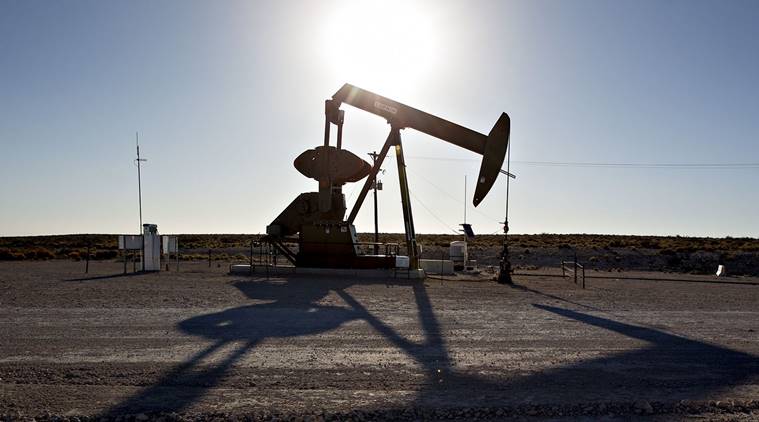Explained: What explains crude oil prices falling below the $0 mark
US oil markets created history on Monday when prices of West Texas Intermediate (WTI), the best quality of crude oil in the world, fell to “minus” $40.32 a barrel in New York. Not only is this the lowest crude oil price ever known — according to Bloomberg, the previous lowest was immediately after World War II — but also well below the zero-mark.
At this price, the seller would be paying the buyer of crude oil $40 for each barrel that is bought.
But how can that be? How did prices fall below zero in the first place? Why would they fall from $0 to -$5 to -$10 and so on all the way to -$40 a barrel? To be sure, regardless of how it looks, this is not an illogical result.
The context
The first thing to understand is that, even before the Covid-19 induced global lockdown, crude oil prices had been falling over the past few months. They were closer to $60 a barrel at the start of 2020 and by March-end, they were closer to $20 a barrel.
The reason was straightforward. The price of a commodity falls when supply is more than demand. To a great extent, oil markets, globally and more so in the US, are facing an enormous glut.
Historically, the Organization of the Petroleum Exporting Countries (OPEC), lead by Saudi Arabia, which is the largest exporter of crude oil in the world (single-handedly exporting 10% of the global demand), used to work as a cartel and fix prices in a favourable band. It could bring down prices by increasing oil production and raise prices by cutting production.
In the recent past, the OPEC has been working with Russia, as OPEC+, to fix the global prices and supply.
It must be understood that cutting production or completely shutting down an oil well is a difficult decision because restarting it is both costly and cumbersome. Moreover, if one country cuts production, it risks losing market share if others do not follow suit.
The global oil pricing is by no stretch an example of a well-functioning competitive market. In fact, it’s seamless operations crucially depend on oil exporters acting in consort.
The start of trouble
But in early March, this happy accord came to an end as Saudi Arabia and Russia disagreed over the production cuts required to keep prices stable. As a result, oil-exporting countries, led by Saudi Arabia, started undercutting each other on price while continuing to produce the same quantities of oil.
This was an unsustainable strategy under normal circumstances but what made it even more calamitous was the growing spread of Coronavirus, which, in turn, was sharply reducing economic activity and the demand for oil. With each passing day, the developed countries were falling prey to Covid-19 and with each lockdown, there were fewer flights to be boarded, fewer cars to be used etc.
 A pumpjack operates on an oil well in the Permian Basin near Orla, Texas. (Bloomberg Photo)
A pumpjack operates on an oil well in the Permian Basin near Orla, Texas. (Bloomberg Photo)
Enter Covid-19
By the time the Saudi Arabia and Russia discord was sorted out last week, under pressure from US President Donald Trump, it was possibly too late. Oil-exporting countries decided to cut production by 6 million barrels a day — the highest production cuts — and yet the demand for oil was shrinking by 9 to 10 million barrels a day.
This meant that the supply-demand mismatch continued to worsen right through March and April. According to reports, all possible the mismatch resulted in almost all storage capacity being exhausted. Trains and ships, which were typically used to transport oil, too, were used up just for storing oil.
It is also crucial here to understand that the US became the largest producer of crude oil in 2018. And that is one reason why, unlike all the previous US Presidents, who always pushed for lower crude oil prices, especially in an election year, Donald Trump has been pushing for higher oil prices.
What happened on Monday
The May contracts for WTI, the American crude oil variant, were due to expire on Tuesday, April 21. As the deadline came near, prices started plummeting. This was for two broad reasons.
By Monday, there were many oil producers who wanted to get rid of their oil even at unbelievably low prices instead of choosing the other option — shutting production, which would have been costlier to restart when compared to the marginal loss on May sales.
From the consumer side, that is those holding these contracts, it was an equally big headache. Contract holders wanted to wriggle out of the compulsion to buy more oil as they realised, quite late in hindsight, that there was no space to store the oil if they were to take the delivery.
 Unused oil rigs sit in the Gulf of Mexico near Port Fourchon, Louisiana. (Reuters Photo: Lee Celano)
Unused oil rigs sit in the Gulf of Mexico near Port Fourchon, Louisiana. (Reuters Photo: Lee Celano)
They figured that it would be more costly for them to accept the oil delivery, pay for its transportation and then pay for storing it (possibly for a longish period, given the circumstances) especially when there is no storage available than to simply take a hit on the contract price.
This desperation from both sides — buyers and sellers — to get rid of oil meant the oil prices not only plummeted to zero but also went deep into the negative territory.
In the short-term, for both — the holders of the delivery contract and the oil producers — it was less costly to pay $40 a barrel and get rid of the oil instead of storing it (buyers) or stopping production (producers).
Oil prices in the future
It is important to note that it was the WTI price for May in the US markets that went so low. Crude Oil prices elsewhere fell but by not so much. Moreover, at least for now, oil prices for June are pegged at around $20 a barrel.
It is likely that this was a one-off event and will not happen as producers are forced to cut back production further.
But one cannot rule out a repeat of the Monday drama because, with Covid-19 continuing to spread, demand is falling every day.
In the end, it would be the demand-supply mismatch (adjusted for how much can be stored away) that will decide the fate of oil prices.
INDIAN EXPRESS





